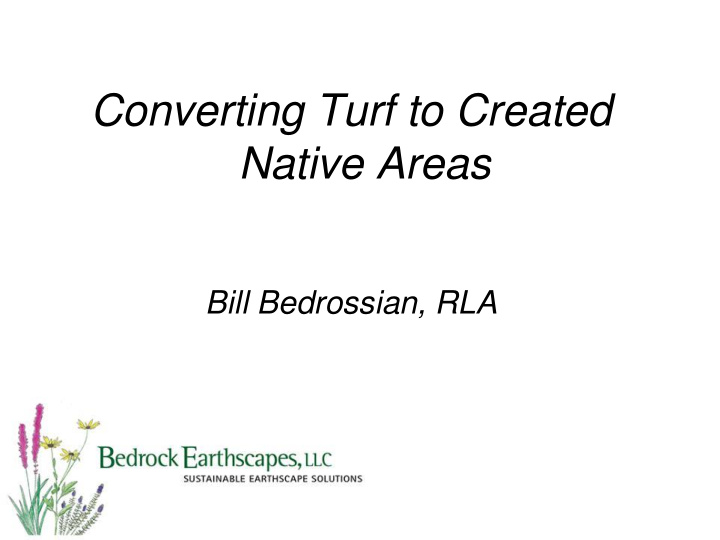



Converting Turf to Created Native Areas Bill Bedrossian, RLA
Why Convert Turf to Natives?
Benefits of Native Plant BMPs • Runoff reduction and enhanced infiltration • Water quality enhancement • Air quality enhancement • Eliminate need for irrigation and chemicals • Promote groundwater recharge • Reduction of conventional stormwater infrastructure • Enhance bio-diversity and habitat quality • Pleasing aesthetic throughout the year • Opportunities to promote education and awareness • Long Term Maintenance Cost Reduction (Up to 80% Annual Maintenance savings after establishment !!!)
Historical Patterns of Hydrology Recharge Zone: Uplands Discharge Zones: Lowlands- rivers, streams, ponds, wetlands Constant, clean discharge flows, year round to sustain stable surface water hydrology with constant water temperature and chemistry
Contemporary Hydrology Upland becomes discharge zone Natural wetlands are expected to function as recharge zones Reversed hydrological pattern results in runoff containing sediments, oils, greases, salts, fertilizers, pesticides, and higher water temperatures that inundate historical systems adapted to completely different hydrological and water quality conditions
Turf to natives is one part of a larger picture Integrated Water Treatment Train • Porous pavement systems • Rainwater harvesting and re-use • Green roof systems • Bio-retention systems • Native landscape systems • Other site elements- energy, wastewater, etc.
Key concepts to keep in mind: Plants will only grow in habitats to which they are adapted. We are re-creating native plantings in the built environment and in disturbed areas.
Low profile mixed native plantings
Native forb (flowers) dominated plantings
Native grass dominated native plantings
Turf to Native Plantings • Where is it done? • Why? Enriching life through improving our environment. • How? A few examples of voluntary (not required) turf to native conversions
Naperville Park District
Naperville Park District
Chestnut Park, Darien Park District
Chestnut Park, Darien Park District
Chestnut Park, Darien Park District
Chestnut Park, Darien Park District
Cover Crop
Cover Crop
Munson Basin, Carol Stream
Munson Basin, Carol Stream
Munson Basin, Carol Stream
Munson Basin, Carol Stream
Munson Basin, Carol Stream
Roosevelt University
Roosevelt University
Roosevelt University
High Grove Naperville
High Grove Naperville
High Grove Naperville
Pheasant Hollow HOA
Hawthorne Elementary School
Some Native Plant Field Notes • These are not “natural” areas. They are created native plantings. Modify the seed/plant mix to the location. • Plants will only grow in habitats to which they are adapted. • 3-5 years for establishment. Consider use of a showy cover crop. • Think about native plant structure in the built environment.
A few last thoughts • Native plantings need to be an important part of our water treatment train. • Rain water and organic matter are not “waste” products. • “Green infrastructure” systems DO require maintenance to perform to their design specifications.
The future: More Natives, Less Turf Native plants are not as widely used as they should be! Thank you for helping to change that!
Enriching life through improving our environment • Native Areas maintenance and restoration • Native Plantings for resource and cost reduction • Over 47 years of Landscape Management experience
Recommend
More recommend